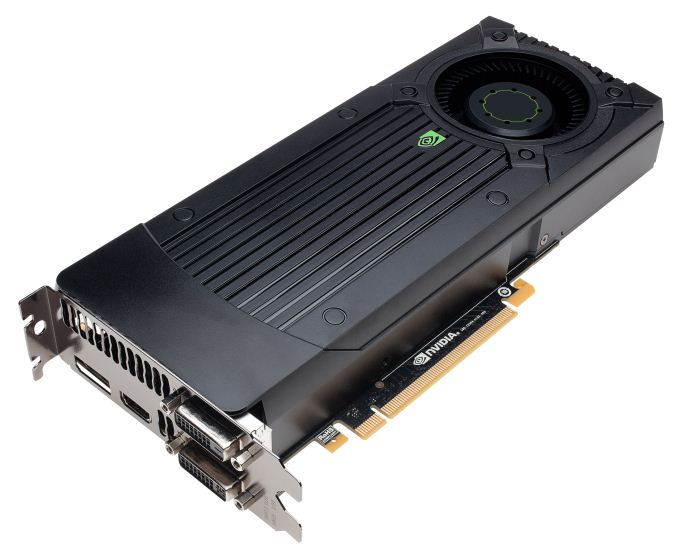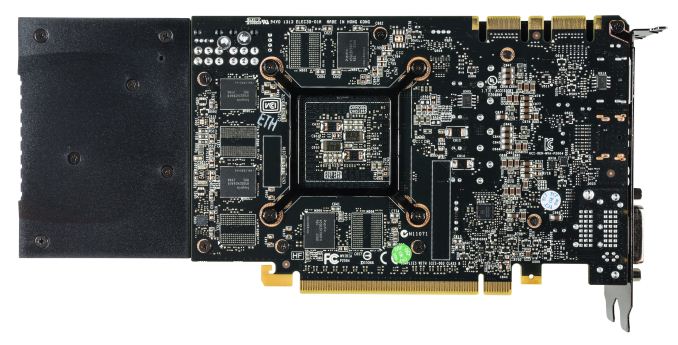NVIDIA GeForce GTX 760 Review: The New Enthusiast Kepler
by Ryan Smith on June 25, 2013 9:00 AM ESTMeet the GeForce GTX 760
As we mentioned earlier, due to its 170W TDP the GTX 760 is essentially a drop-in replacement for the GTX 670 in board designs. Even NVIDIA’s reference design reflects this, with the reference GTX 760 being based on the reference GTX 670’s cooler and PCB. Consequently there’s not much to say about the GTX 760’s design that we haven’t said before. If you’ve seen a GTX 670 then you’ve seen a GTX 760, down to the last screw. For consistency we’ll quickly go over the GTX 760’s design, but this is generally a rehash of what we’ve already said about the GTX 670.
Like GTX 670 before it, GTX 760 is another “small” GK104 design. The complete card is 9.5” long, however the actual PCB is far shorter at only 6.75” long, 3.75” shorter than the GTX 770’s PCB. In fact it would be fair to say that rather than strapping a cooler onto a card, NVIDIA strapped a card onto a cooler. Meanwhile we see that once again NVIDIA is using Hynix R0C (6GHz) GDDR5 RAM here.
The cooler itself is fairly simple, utilizing an aluminum heatsink melded with a copper base plate. A separate heatsink covers the VRM circuitry – once again mounted at the front of the card – while the fan hangs off of the rear of the card. This unfortunately is the same fan as on the GTX 670, which means it makes a faint grinding sound at low RPMs. This design has proven more than adequate for the GTX 670s, though it does leave some room for NVIDIA’s partners to improve on overall cooling performance, especially with open air coolers.
Elsewhere at the top of the card we’ll find the PCIe power sockets and SLI connectors. Two 6-pin PCIe sockets provide the necessary external power, while a pair of SLI bridge connectors at the other end allow for up to 3-way SLI. NVIDIA’s standard I/O configuration also makes an appearance here, offering 2x DL-DVI, 1x HDMI, 1x DisplayPort 1.2.
Looking at clockspeed bins for a moment, it comes as no great surprise that like the GTX 770, the GTX 760 operates at 1.2v at its highest stock clockspeed bin. The higher voltage versus the 1.76v limit on the 600 series causes power consumption to jump up more rapidly at the highest bins, but is necessary to unlock the 1100MHz+ clockspeeds the card is capable of.
| GeForce Clockspeed Bins | ||||
| Clockspeed | GTX 770 | GTX 760 | ||
| 1162MHz | N/A | 1.212v | ||
| 1149MHz | 1.212v | 1.2v | ||
| 1136MHz | 1.2v | 1.187v | ||
| 1123MHz | 1.187v | 1.162v | ||
| 1110MHz | 1.162v | 1.15v | ||
| 1097MHz | 1.15v | 1.137v | ||
| 1084MHz | 1.137v | 1.125v | ||
| 1071MHz | 1.125v | 1.112v | ||
| 1058MHz | 1.112v | 1.1v | ||
| 1045MHz | 1.1v | 1.087v | ||
Finaly, for overclockers there is one further bin (1162MHz) available via overvolting to 1.212v. The maximum power target meanwhile is 115%, for a final power limit of 195W.
















110 Comments
View All Comments
YukaKun - Tuesday, June 25, 2013 - link
And where's my beloved GTX670?! Are you guys hiding something here that nVidia doesn't want me to see?No, but really; I know it's not it's direct replacement, but I'd really like to see the numbers how they stack up.
Cheers!
Ryan Smith - Tuesday, June 25, 2013 - link
The GTX 670 is in all of our charts. All of this data is also on Bench.YukaKun - Tuesday, June 25, 2013 - link
Yeah, just realized it is... I wonder why I didn't see it, lol.Selective reading at its finest indeed.
Thanks Ryan!
HisDivineOrder - Tuesday, June 25, 2013 - link
AMD is now saying the Never Settle Reloaded bundle is running out at retailers. That means, you should be mentioning that it isn't going to last much longer and doesn't really factor into the value of the 7950/7950B unless they decide to renew it.I suspect though they'll do a price drop soon.
DanNeely - Tuesday, June 25, 2013 - link
I'd expect them to create a new bundle instead.kallogan - Tuesday, June 25, 2013 - link
Too big, barely better than 660 ti at higher power consumption. What's the point ?MrSpadge - Tuesday, June 25, 2013 - link
Too big: there will loads of custom coolers, just like on the current cards. Shorter ones as well.barely better than 660 ti at higher power consumption: the additional performance is approximately proportional to the added power draw, so efficiency hardly suffers. Of course I'll stick with my OC'ed 660Ti, but this newcomer is just more balanced for everything but the most pure compute tasks.
What's the point: cheaper for nVidia to produce (one SMX less) and sold cheaper. It's a win-win.
jimwatkins - Tuesday, June 25, 2013 - link
I suppose this is of little interest to most readers, but since your doing computer performance, how about a bitcoin GH performance chart. Video cards are actually of waning value in the bitcoin arms race but it's an interesting aspect of compute performance nonetheless and the high end AMD cards certainly still produce value.dcianf - Tuesday, June 25, 2013 - link
I'm excited to see them maintain compatibility with my 660Ti/670 full card waterblock. PLEASE LET THIS BE A NEW STANDARD!JimmiG - Tuesday, June 25, 2013 - link
Well it's hotter, more power hungry and louder than the GTX 670 while still being slower, which is kind of disappointing for something that's supposed to be an evolution of the GTX 600 series. Still, it does feel like "GTX 660 Done Right" in some ways, as that card was always too slow, forcing people to pay $400 for the GTX 670.It's sad that prices have been creeping up so much without people noticing. $499 used to be the "ultra-enthusiast" segment, and $199 would buy you a very decent card. In 2012 and early 2013, $400 was the "mid-range" and $999 the "ultra high-end". GTX 760 brings the mid-range back to $250 again, at least until the GTX 860 come out at $499...